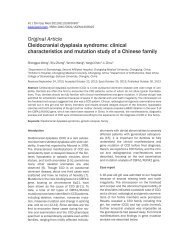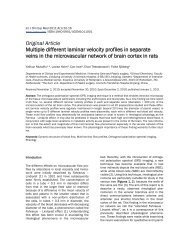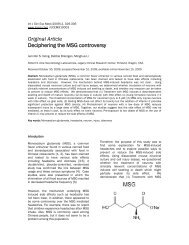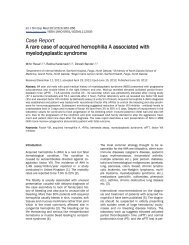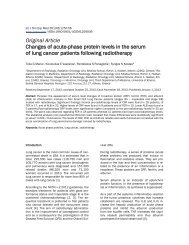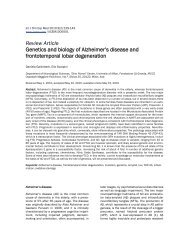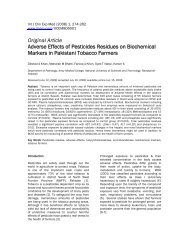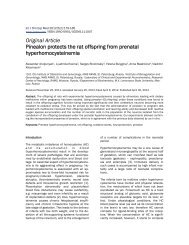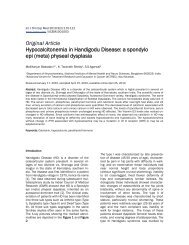Role of myeloid-specific G-protein coupled receptor kinase-2 in sepsis
Role of myeloid-specific G-protein coupled receptor kinase-2 in sepsis
Role of myeloid-specific G-protein coupled receptor kinase-2 in sepsis
Create successful ePaper yourself
Turn your PDF publications into a flip-book with our unique Google optimized e-Paper software.
Int J Cl<strong>in</strong> Exp Med 2011;4(4):320-330<br />
www.ijcem.com /ISSN:1940-5901/IJCEM1110006<br />
Orig<strong>in</strong>al Article<br />
<strong>Role</strong> <strong>of</strong> <strong>myeloid</strong>-<strong>specific</strong> G-<strong>prote<strong>in</strong></strong> <strong>coupled</strong> <strong>receptor</strong><br />
<strong>k<strong>in</strong>ase</strong>-2 <strong>in</strong> <strong>sepsis</strong><br />
Sitaram Parvataneni 1 , Babu Gonipeta 1 , Nandakumar Packiriswamy 2 , Taehyung Lee 1 , Haritha Durairaj 1 ,<br />
Narayanan Parameswaran 1,2<br />
1Department <strong>of</strong> Physiology, Michigan State University, East Lans<strong>in</strong>g, MI; 2 Graduate program <strong>in</strong> Comparative Medic<strong>in</strong>e<br />
and Integrative Biology, Michigan State University, East Lans<strong>in</strong>g, MI, USA<br />
Received October 21, 2011; accepted November 5, 2011, 2011; Epub November 9, 2011; Published November 30,<br />
2011<br />
Abstract: Previous studies have implicated a critical role for G-<strong>prote<strong>in</strong></strong> <strong>coupled</strong> <strong>receptor</strong> <strong>k<strong>in</strong>ase</strong>-2 (GRK2) <strong>in</strong> <strong>sepsis</strong><br />
ow<strong>in</strong>g to its ability to regulate <strong>in</strong>flammatory response and chemotaxis <strong>of</strong> immune cells. We therefore, hypothesized<br />
that deletion <strong>of</strong> GRK2 <strong>in</strong> <strong>myeloid</strong> cells would significantly modulate the pathogenesis <strong>of</strong> polymicrobial <strong>sepsis</strong>. To test<br />
this hypothesis, we <strong>in</strong>duced cecal ligation and puncture (CLP), <strong>in</strong> mice with <strong>myeloid</strong>-<strong>specific</strong> deletion <strong>of</strong> GRK2 and the<br />
correspond<strong>in</strong>g GRK2 wild type littermates and determ<strong>in</strong>ed the <strong>in</strong>flammatory response (IL-6 and IL-10), immune cell<br />
<strong>in</strong>filtration, bacterial load and survival. Six hours after surgery, plasma IL-6 and IL-6:IL-10 ratios were significantly<br />
enhanced <strong>in</strong> the GRK2 knockouts compared to the GRK2 wild type mice. Compared to these effects, IL-6was significantly<br />
elevated <strong>in</strong> the bronchoalveolar lavage but not <strong>in</strong> the peritoneal fluid <strong>of</strong> the GRK2 knockout mice. On the other<br />
hand, peritoneal IL-10 was significantly elevated <strong>in</strong> the GRK2 knockout mice compared to the GRK2 wild type. Even<br />
though GRK2 knockout mice exhibited an exaggerated cytok<strong>in</strong>e response, there was no difference <strong>in</strong> immune cell<br />
<strong>in</strong>filtration <strong>in</strong>to the primary site <strong>of</strong> <strong>in</strong>fection or <strong>in</strong> bacterial clearance when compared between the GRK2 wild type and<br />
GRK2 knockout mice after surgery. Furthermore, <strong>in</strong> spite <strong>of</strong> the enhanced pro-<strong>in</strong>flammatory pr<strong>of</strong>ile early after surgery,<br />
there was only a modest <strong>in</strong>crease <strong>in</strong> mortality <strong>in</strong> the GRK2 knockout compared to the GRK2 wild type mice after CLP.<br />
Together, our studies demonstrate that <strong>myeloid</strong>-<strong>specific</strong> knockout <strong>of</strong> GRK2 renders the mice more susceptible to an<br />
early pro-<strong>in</strong>flammatory state. However, <strong>myeloid</strong>-<strong>specific</strong> GRK2 is not <strong>in</strong>volved <strong>in</strong> immune cell <strong>in</strong>filtration to the primary<br />
site <strong>of</strong> <strong>in</strong>fection or <strong>in</strong> bacterial clearance and does not significantly modulate mortality <strong>in</strong> the cecal ligation puncture<br />
model <strong>of</strong> polymicrobial <strong>sepsis</strong>.<br />
Keywords: G-<strong>prote<strong>in</strong></strong> <strong>coupled</strong> <strong>receptor</strong> <strong>k<strong>in</strong>ase</strong>-2 (GRK2), <strong>in</strong>flammation, <strong>sepsis</strong>, GRK2 knockout mice<br />
Introduction<br />
G-<strong>prote<strong>in</strong></strong> <strong>coupled</strong> <strong>receptor</strong> <strong>k<strong>in</strong>ase</strong>-2 (GRK2) is<br />
one <strong>of</strong> the seven members <strong>of</strong> the G-<strong>prote<strong>in</strong></strong> <strong>coupled</strong><br />
<strong>receptor</strong> <strong>k<strong>in</strong>ase</strong>s (GRKs) that are ser<strong>in</strong>e/<br />
threon<strong>in</strong>e <strong>k<strong>in</strong>ase</strong>s and are widely distributed <strong>in</strong><br />
different tissues [1]. GRKs <strong>in</strong> general and GRK2<br />
<strong>in</strong> particular have been shown to play a crucial<br />
role <strong>in</strong> various cell signal<strong>in</strong>g and cell biological<br />
processes, rang<strong>in</strong>g from <strong>receptor</strong> phosphorylation<br />
and desensitization, to MAPK signal<strong>in</strong>g,<br />
chemotaxis, and <strong>in</strong>flammatory cytok<strong>in</strong>e production<br />
[2-10]. Even though GRKs were orig<strong>in</strong>ally<br />
discovered for their role <strong>in</strong> GPCR phosphorylation,<br />
their role <strong>in</strong> <strong>receptor</strong> biology and cell signal<strong>in</strong>g<br />
has considerably expanded <strong>in</strong> the last<br />
decade. Thus, while GRK2 (orig<strong>in</strong>ally named β-<br />
adrenergic <strong>receptor</strong> <strong>k<strong>in</strong>ase</strong>) was discovered for<br />
its role <strong>in</strong> phosphorylation <strong>of</strong> β-adrenergic <strong>receptor</strong>,<br />
recent studies suggest an important role for<br />
this <strong>k<strong>in</strong>ase</strong> <strong>in</strong> <strong>in</strong>flammation and <strong>in</strong>flammatory<br />
diseases [11, 12].<br />
Several studies have shown that GRK2 levels<br />
are altered <strong>in</strong> human patients suffer<strong>in</strong>g from<br />
different <strong>in</strong>flammatory diseases <strong>in</strong>clud<strong>in</strong>g <strong>sepsis</strong><br />
[13-16]. Similar f<strong>in</strong>d<strong>in</strong>gs have also been reported<br />
<strong>in</strong> animal models <strong>of</strong> <strong>in</strong>flammatory disease<br />
[17, 18] and <strong>in</strong> immune cells <strong>in</strong> vitro [19,<br />
20]. By virtue <strong>of</strong> its role <strong>in</strong> regulat<strong>in</strong>g GPCRs,<br />
GRK2 has been shown to be a critical modulator<br />
<strong>of</strong> chemotaxis, mediated by chemok<strong>in</strong>e <strong>receptor</strong>s.<br />
For example, <strong>in</strong>creased expression <strong>of</strong><br />
GRK2 <strong>in</strong> neutrophils from septic patients was
Myeloid-<strong>specific</strong> G-<strong>prote<strong>in</strong></strong> <strong>coupled</strong> <strong>receptor</strong> <strong>k<strong>in</strong>ase</strong>-2 <strong>in</strong> <strong>sepsis</strong><br />
shown to correlate with significantly reduced<br />
chemotaxis [13]. In previous studies, we exam<strong>in</strong>ed<br />
the role <strong>of</strong> GRK2 <strong>in</strong> an endotoxemia model<br />
<strong>in</strong> mice us<strong>in</strong>g <strong>myeloid</strong>-<strong>specific</strong> knockout <strong>of</strong><br />
GRK2 [9]. We found <strong>myeloid</strong>-<strong>specific</strong> GRK2 to<br />
be an important negative regulator <strong>of</strong> endotoxemia<br />
<strong>in</strong> vivo, and furthermore, demonstrated that<br />
this role <strong>of</strong> GRK2 may be related to its effect on<br />
Toll-like <strong>receptor</strong>-4-<strong>in</strong>duced NFκB1p105-ERK<br />
pathway <strong>in</strong> macrophages. Together, based on<br />
these studies we hypothesized that <strong>myeloid</strong><strong>specific</strong><br />
knockout <strong>of</strong> GRK2 will significantly<br />
modulate the outcome <strong>of</strong> polymicrobial <strong>sepsis</strong>.<br />
To address the role <strong>of</strong> GRK2 <strong>in</strong> a cl<strong>in</strong>ically relevant<br />
model <strong>of</strong> polymicrobial <strong>sepsis</strong>, <strong>in</strong> this study<br />
we used a cecal-ligation and puncture model <strong>of</strong><br />
septic shock [21]. This model is <strong>in</strong>duced by polymicrobial<br />
septic peritonitis, evoked by cecal<br />
ligation and puncture. Of the different models <strong>of</strong><br />
<strong>sepsis</strong>, CLP has been shown to be more ak<strong>in</strong> to<br />
the development <strong>of</strong> human <strong>sepsis</strong> [22]. While<br />
this model also has its drawbacks, the <strong>in</strong>flammatory<br />
response that develops has similar k<strong>in</strong>etics<br />
to that <strong>of</strong> cl<strong>in</strong>ical <strong>sepsis</strong>. Thus, <strong>in</strong> this<br />
study we exam<strong>in</strong>ed the role <strong>of</strong> <strong>myeloid</strong>-<strong>specific</strong><br />
GRK2 <strong>in</strong> cecal-ligation and puncture model <strong>in</strong><br />
mice. We found that consistent with our results<br />
<strong>in</strong> endotoxemia model <strong>myeloid</strong>-<strong>specific</strong> GRK2<br />
knockout mice have a slightly exaggerated <strong>in</strong>flammatory<br />
response compared to the GRK2<br />
wild type mice. Our results however suggest<br />
that, <strong>in</strong> this model, <strong>myeloid</strong> <strong>specific</strong>-GRK2 may<br />
not play an important role <strong>in</strong> either peritoneal<br />
cell chemotaxis or <strong>in</strong> clearance <strong>of</strong> bacterial load<br />
after septic peritonitis.<br />
Materials and methods<br />
Animals<br />
All animal procedures were approved by the<br />
Michigan State University Institutional Animal<br />
Care and Use Committee and conformed to National<br />
Institutes <strong>of</strong> Health guidel<strong>in</strong>es. Animals<br />
were housed four to five mice per cage at 22-<br />
24°C <strong>in</strong> rooms with 50% humidity and a 12-h<br />
light-dark cycle. All animals were given mouse<br />
chow and water ad libitum. Myeloid-<strong>specific</strong><br />
GRK2 deficient mice were generated as described<br />
before [9]. Briefly, GRK2 fl/fl mice <strong>in</strong><br />
which exons 3-6 <strong>of</strong> GRK2 are flanked by LoxP<br />
sites (k<strong>in</strong>dly provided by Dr. Gerald Dorn II,<br />
Wash<strong>in</strong>gton University school <strong>of</strong> Medic<strong>in</strong>e, St.<br />
Louis), were crossed with LysMCre mice to generate<br />
GRK2 fl/flLysMCre mice [9, 23, 24]. A breed<strong>in</strong>g<br />
colony was ma<strong>in</strong>ta<strong>in</strong>ed by mat<strong>in</strong>g GRK2 fl/fl with<br />
GRK2 fl/fl+LysMCre . The mice were generated on a<br />
mixed C57BL6/129sv background. GRK2 fl/<br />
fl+LysMCre were used <strong>in</strong> experiments and compared<br />
to littermate GRK2 fl/fl controls.<br />
Cecal ligation and puncture<br />
Cecal ligation and puncture was performed as<br />
described before [25]. Briefly, GRK2 wild type<br />
and <strong>myeloid</strong> <strong>specific</strong> knockout mice (males, 8-<br />
12 weeks old) were anesthetized with Ketam<strong>in</strong>e<br />
(80 mg/kg body weight) and Xylaz<strong>in</strong>e (5 mg/kg<br />
body weight). Before surgery the abdom<strong>in</strong>al sk<strong>in</strong><br />
was shaved under aseptic conditions followed<br />
by a ~1.5 cm midl<strong>in</strong>e <strong>in</strong>cision to expose the<br />
cecum. The cecum was tightly ligated with a 4.0<br />
silk suture at the base below the ileo-cecal<br />
valve. This was followed by puncture with a 20-<br />
G needle (two punctures). The cecum was gently<br />
squeezed to extrude small fecal matter and<br />
then returned to the peritoneal cavity. The <strong>in</strong>cision<br />
was then closed with a 4.0 silk. The animals<br />
were returned to their cages with adlibidum<br />
access to food and water. Sham mice<br />
underwent identical protocol except ligation and<br />
puncture. Mice were sacrificed at various time<br />
po<strong>in</strong>ts as <strong>in</strong>dicated and blood collected. Peritoneal<br />
and bronchoalveolar lavage fluids were<br />
collected as described before [9, 26]. For survival<br />
studies mice were monitored for 7 days.<br />
Differences <strong>in</strong> survival were analyzed us<strong>in</strong>g a<br />
log-rank test (Prism 5 s<strong>of</strong>tware, Graph Pad S<strong>of</strong>tware,<br />
La Jolla, CA).<br />
Cytok<strong>in</strong>e analysis<br />
Plasma and body fluids (peritoneal, and bronchoalveolar<br />
lavage) were used to assess the<br />
cytok<strong>in</strong>e levels us<strong>in</strong>g Enzyme L<strong>in</strong>ked Immunosorbent<br />
Assay (ELISA) kits from eBioscience,<br />
Inc. (San Diego, CA 92121, USA) as described<br />
before [27].<br />
Flow cytometry and cell analysis<br />
Surface sta<strong>in</strong><strong>in</strong>g and flow cytometry were performed<br />
as described before [10]. Briefly, cells<br />
obta<strong>in</strong>ed from peritoneal lavage fluid was<br />
washed and sta<strong>in</strong>ed with antibodies for various<br />
surface markers <strong>in</strong>clud<strong>in</strong>g CD11b, Ly6G, and<br />
F4/80, to identify neutrophil and macrophage<br />
populations. Data were acquired us<strong>in</strong>g a LSRII<br />
(BD Biosciences) and analyzed us<strong>in</strong>g Flowjo<br />
321 Int J Cl<strong>in</strong> Exp Med 2011;4(4):320-330
Myeloid-<strong>specific</strong> G-<strong>prote<strong>in</strong></strong> <strong>coupled</strong> <strong>receptor</strong> <strong>k<strong>in</strong>ase</strong>-2 <strong>in</strong> <strong>sepsis</strong><br />
s<strong>of</strong>tware (Tree Star) as described before [10,<br />
27].<br />
Statistical analysis<br />
All values are represented as mean±SEM. Data<br />
were analyzed and statistics performed us<strong>in</strong>g<br />
GRAPHPAD PRISM s<strong>of</strong>tware (La Jolla, California).<br />
The Student’s t-test was used to compare<br />
mean values between two experimental groups<br />
and Analysis <strong>of</strong> Variance (ANOVA) with Bonferroni<br />
Post-hoc test was used to compare more<br />
than two groups. P value <strong>of</strong> less than 0.05 was<br />
considered significant.<br />
Results<br />
Systemic <strong>in</strong>flammatory response after cecal<br />
ligation and puncture (CLP): In previous studies<br />
we reported the <strong>in</strong>itial characterization <strong>of</strong> the<br />
<strong>myeloid</strong>-<strong>specific</strong> GRK2 knockout mice. We demonstrated<br />
that GRK2 levels are significantly reduced<br />
<strong>in</strong> the macrophages and neutrophils, but<br />
is still present at equivalent levels (compared to<br />
the GRK2 wild types) <strong>in</strong> various organ tissues<br />
exam<strong>in</strong>ed <strong>in</strong> the GRK2 knockout mice [9]. To<br />
understand the role <strong>of</strong> <strong>myeloid</strong>-<strong>specific</strong> GRK2 <strong>in</strong><br />
<strong>sepsis</strong>, we <strong>in</strong>duced cecal ligation and puncture<br />
(CLP) (or sham surgery) <strong>in</strong> both the GRK2 wild<br />
type and the <strong>myeloid</strong>-<strong>specific</strong> GRK2 knockout<br />
mice (GRK2MyeKO) and subsequently measured<br />
various cytok<strong>in</strong>es <strong>in</strong> the plasma at various<br />
time po<strong>in</strong>ts after surgery. In prelim<strong>in</strong>ary 23-plex<br />
cytok<strong>in</strong>e analyses, we found that plasma IL-6<br />
and IL-10 levels were the only cytok<strong>in</strong>es modulated<br />
by GRK2 (data not shown). Therefore, we<br />
focused on these two cytok<strong>in</strong>es and measured<br />
their levels <strong>in</strong> the plasma us<strong>in</strong>g ELISA. Plasma IL<br />
-6 but not IL-10 levels were significantly enhanced<br />
<strong>in</strong> the GRK2 knockout, early after surgery<br />
(6 hours after CLP) (Figure 1). To determ<strong>in</strong>e<br />
the systemic pro- versus anti-<strong>in</strong>flammatory<br />
status <strong>of</strong> the animals [28, 29], we compared<br />
the ratios <strong>of</strong> the plasma IL-6:IL-10 between<br />
GRK2 wild type and GRK2 knockout mice. Interest<strong>in</strong>gly,<br />
6 hours after surgery, plasma IL-6:IL-10<br />
ratio was significantly elevated <strong>in</strong> the GRK2<br />
knockout mice (Figure 1). Given the important<br />
pro- and anti-<strong>in</strong>flammatory roles <strong>of</strong> IL-6 and IL-<br />
10 respectively <strong>in</strong> this model <strong>of</strong> <strong>sepsis</strong> [30],<br />
higher ratio <strong>of</strong> IL-6:IL-10 <strong>in</strong> the GRK2 knockout<br />
mice suggests that early after surgery the GRK2<br />
knockout mice are biased towards a pro<strong>in</strong>flammatory<br />
state compared to the GRK2 wild<br />
type mice.<br />
Figure 1. Plasma cytok<strong>in</strong>e levels <strong>in</strong> <strong>myeloid</strong>-<strong>specific</strong><br />
GRK2 knockout (GRK2MyeKO) and wild type littermate<br />
(GRK2 WT) mice after septic peritonitis: Mice<br />
from both genotypes were subjected to cecal ligation<br />
and puncture (CLP) or sham surgery (SHAM) and<br />
sacrificed at <strong>specific</strong> time po<strong>in</strong>ts as shown. Plasma<br />
levels <strong>of</strong> IL-6, and IL-10 were measured us<strong>in</strong>g ELISA.<br />
*P
Myeloid-<strong>specific</strong> G-<strong>prote<strong>in</strong></strong> <strong>coupled</strong> <strong>receptor</strong> <strong>k<strong>in</strong>ase</strong>-2 <strong>in</strong> <strong>sepsis</strong><br />
Inflammatory response <strong>in</strong> the lungs<br />
In order to exam<strong>in</strong>e the role <strong>of</strong> GRK2 <strong>in</strong> tissue<br />
compartments we determ<strong>in</strong>ed the <strong>in</strong>flammatory<br />
response <strong>in</strong> the lungs. Lungs are one <strong>of</strong> the major<br />
tissue sites affected after <strong>sepsis</strong> and therefore<br />
we exam<strong>in</strong>ed the cytok<strong>in</strong>e levels <strong>in</strong> the<br />
bronchoalveolar lavage fluid (BALF) after CLP.<br />
Twelve hours after CLP, IL-6 levels <strong>in</strong> the GRK2<br />
wild type and GRK2 knockout mice were significantly<br />
elevated compared to the shams. Importantly,<br />
IL-6 level <strong>in</strong> the BALF was significantly<br />
enhanced <strong>in</strong> the GRK2 knockout mice compared<br />
to the GRK2 wild type mice (Figure 2). IL-<br />
10 levels however, did not differ between the<br />
genotypes <strong>in</strong> the BALF (Figure 2).<br />
GRK2 wild type and the GRK2 knockout mice<br />
(Figure 3).<br />
Figure 2. Cytok<strong>in</strong>e levels <strong>in</strong> the Broncho-Alveolar Lavage<br />
Fluid (BALF) after septic peritonitis: Myeloid<strong>specific</strong><br />
GRK2 knockout and the wild type littermate<br />
mice were subjected to CLP or Sham as described <strong>in</strong><br />
Figure 1. Broncho alveolar lavage fluid was collected<br />
as described before [9]. The fluid portion <strong>of</strong> the BALF<br />
was then tested for cytok<strong>in</strong>es us<strong>in</strong>g ELISA. *P
Myeloid-<strong>specific</strong> G-<strong>prote<strong>in</strong></strong> <strong>coupled</strong> <strong>receptor</strong> <strong>k<strong>in</strong>ase</strong>-2 <strong>in</strong> <strong>sepsis</strong><br />
Infiltration <strong>of</strong> immune cells <strong>in</strong>to the primary site<br />
<strong>of</strong> <strong>in</strong>fection (peritoneum)<br />
Immune cell <strong>in</strong>filtration <strong>in</strong>to the peritoneum after<br />
CLP surgery is an important event <strong>in</strong> the<br />
pathogenesis <strong>of</strong> <strong>sepsis</strong> [31, 32]. GRK2 has previously<br />
been shown to be important for chemotaxis<br />
<strong>in</strong> other models [7, 33]. Therefore, we assessed<br />
the total <strong>in</strong>filtration <strong>of</strong> immune cells <strong>in</strong>to<br />
the peritoneum after CLP <strong>in</strong> GRK2 wild type and<br />
GRK2 knockout mice. As would be predicted,<br />
CLP <strong>in</strong>duced a significant <strong>in</strong>crease <strong>in</strong> peritoneal<br />
cells as early as 6 hours after surgery compared<br />
to the sham mice. The high immune cell <strong>in</strong>filtration<br />
persisted even at 18 hours after surgery<br />
(Figure 4). In contrast to the predicted role <strong>of</strong><br />
GRK2 <strong>in</strong> chemotaxis, total peritoneal cell counts<br />
were similar between the GRK2 wild type and<br />
the GRK2 knockout mice at 6, 12, and 18 hour<br />
time po<strong>in</strong>ts after surgery (Figure 4).<br />
were sta<strong>in</strong>ed for F4/80, Ly6G and CD11b to<br />
differentiate macrophages (F4/80 + CD11b + Ly6G<br />
-) and neutrophils (F4/80 - CD11b + Ly6G + ). As<br />
shown <strong>in</strong> Figure 5, there was no significant dif-<br />
Figure 4. Effect <strong>of</strong> septic peritonitis on peritoneal cell<br />
<strong>in</strong>filtration <strong>in</strong> GRK2 wild type and <strong>myeloid</strong>-<strong>specific</strong><br />
GRK2 knockout mice: Total cell counts were performed<br />
on peritoneal lavage from mice subjected to<br />
sham or CLP (as described <strong>in</strong> Figure 3) at the <strong>in</strong>dicated<br />
time po<strong>in</strong>ts after sacrifice. Total cell counts<br />
were performed us<strong>in</strong>g a Countess automated cell<br />
counter or Cytosp<strong>in</strong>. For total cell counts: Number <strong>of</strong><br />
mice: CLP- 8 mice for 6 hrs, 6 mice for 12 hrs, and<br />
10 mice for 18 hrs for each genotype; Sham- 3-5<br />
mice per genotype for each time po<strong>in</strong>t.<br />
To exam<strong>in</strong>e the differential cell counts peritoneal<br />
cells (after surgery) were treated with various<br />
antibody cocktails to identify neutrophils<br />
and macrophages us<strong>in</strong>g flow cytometry. Cells<br />
Figure 5. Effect <strong>of</strong> septic peritonitis on Ly6G+ and<br />
F4/80+ cells <strong>in</strong> the peritoneal cells from GRK2 wild<br />
type and <strong>myeloid</strong>-<strong>specific</strong> GRK2 knockout mice: Peritoneal<br />
cells from GRK2 wild type and GRK2 knockout<br />
mice were collected 6 hours after surgery (as<br />
described <strong>in</strong> Figure 1) and were prepared for flow<br />
cytometry as described <strong>in</strong> the methods. Sta<strong>in</strong>ed cells<br />
were subjected to flow cytometry. N=4 for each<br />
genotype. *P
Myeloid-<strong>specific</strong> G-<strong>prote<strong>in</strong></strong> <strong>coupled</strong> <strong>receptor</strong> <strong>k<strong>in</strong>ase</strong>-2 <strong>in</strong> <strong>sepsis</strong><br />
Figure 6. Bacterial load <strong>in</strong> various tissue compartments <strong>in</strong> the <strong>myeloid</strong>-<strong>specific</strong> GRK2 knockout and WT littermates<br />
after septic peritonitis: Blood, peritoneal fluid, and various tissue homogenates (collected 18 hours after CLP) were<br />
plated <strong>in</strong> blood agar plates and <strong>in</strong>cubated at 37 C for 24 hours and the number <strong>of</strong> bacterial colonies were counted.<br />
N=10 for WT and N=8 for KO.<br />
ference between the GRK2 wild type and the<br />
GRK2 knockout mice <strong>in</strong> terms <strong>of</strong> the percent <strong>of</strong><br />
macrophages or neutrophils <strong>in</strong>filtrat<strong>in</strong>g <strong>in</strong>to the<br />
peritoneal cavity as assessed by flow cytometry.<br />
Interest<strong>in</strong>gly, however, the expression <strong>of</strong> Ly6G<br />
(as determ<strong>in</strong>ed by mean fluorescence <strong>in</strong>tensity)<br />
but not CD11b was significantly decreased <strong>in</strong><br />
the GRK2 knockout neutrophils (Figure 5).<br />
While Ly6G expression has been associated<br />
with the state <strong>of</strong> neutrophil maturation [34],<br />
how this might expla<strong>in</strong> the exaggerated <strong>in</strong>flammatory<br />
phenotype <strong>of</strong> the GRK2 knockout mice<br />
is not clear. Together, these results suggest that<br />
<strong>myeloid</strong>-<strong>specific</strong> knockout <strong>of</strong> GRK2 does not<br />
regulate the <strong>in</strong>filtration <strong>of</strong> immune cells (total or<br />
differential) <strong>in</strong>to the peritoneal cavity <strong>in</strong> this<br />
model <strong>of</strong> <strong>sepsis</strong>.<br />
Bacterial clearance<br />
An important aspect to the development <strong>of</strong> <strong>sepsis</strong><br />
<strong>in</strong> the CLP model is the clearance <strong>of</strong> bacteria<br />
[31, 32]. Dysregulated clearance <strong>of</strong> bacteria<br />
can lead to excessive bacterial load that will<br />
eventually lead to organ <strong>in</strong>jury and mortality. To<br />
determ<strong>in</strong>e if GRK2 affects clearance <strong>of</strong> bacteria,<br />
we exam<strong>in</strong>ed the bacterial growth from peritoneal<br />
fluid, blood, spleen, lung, liver and mesenteric<br />
lymph node, 18-hours after CLP. As shown<br />
<strong>in</strong> Figure 6, <strong>myeloid</strong>-<strong>specific</strong> knockout <strong>of</strong> GRK2<br />
did not affect the clearance <strong>of</strong> bacteria compared<br />
to the GRK2 wild type mice and showed<br />
similar bacterial loads after surgery.<br />
Mortality after septic peritonitis<br />
Dur<strong>in</strong>g the evolution <strong>of</strong> <strong>sepsis</strong> (after cecal ligation<br />
and puncture), an <strong>in</strong>crease <strong>in</strong> cytok<strong>in</strong>e and<br />
chemok<strong>in</strong>e levels at the local and systemic sites<br />
trigger an <strong>in</strong>crease <strong>in</strong> immune cell <strong>in</strong>filtration<br />
<strong>in</strong>to the local and systemic sites to elim<strong>in</strong>ate the<br />
bacteria [31, 32]. Inappropriate <strong>in</strong>creases <strong>in</strong> the<br />
<strong>in</strong>flammatory cytok<strong>in</strong>es however, can result <strong>in</strong><br />
organ <strong>in</strong>jury and therefore multiple organ dysfunction<br />
[31, 32]. Even though GRK2 knockout<br />
mice had similar bacterial load compared to<br />
that <strong>of</strong> the GRK2 wild type mice, their pro<strong>in</strong>flammatory<br />
status (systemic IL-6:IL-10 ratio)<br />
was exaggerated early after surgery. Therefore,<br />
we reasoned that the multiple organ dysfunc-<br />
325 Int J Cl<strong>in</strong> Exp Med 2011;4(4):320-330
Myeloid-<strong>specific</strong> G-<strong>prote<strong>in</strong></strong> <strong>coupled</strong> <strong>receptor</strong> <strong>k<strong>in</strong>ase</strong>-2 <strong>in</strong> <strong>sepsis</strong><br />
tion and therefore mortality might be higher <strong>in</strong><br />
the GRK2 knockout compared to the GRK2 wild<br />
type mice. As shown <strong>in</strong> Figure 7, CLP caused a<br />
marked <strong>in</strong>crease <strong>in</strong> mortality <strong>in</strong> both GRK2 wild<br />
type and the GRK2 knockout mice. In the GRK2<br />
wild type mice, CLP <strong>in</strong>duced ~40% mortality<br />
with<strong>in</strong> 4 days and rema<strong>in</strong>ed at that level until<br />
day 7. In contrast, <strong>in</strong> the GRK2 knockout mice<br />
CLP caused ~40% mortality by day 2 and by day<br />
7 the mortality <strong>in</strong>creased to ~60%. Because the<br />
bacterial load was not any different between the<br />
GRK2 wild type and the GRK2 knockout mice,<br />
we then reasoned that <strong>in</strong> the presence <strong>of</strong> antibiotics,<br />
the GRK2 knockout mice would still have<br />
an exaggerated IL-6:IL10 ratio and therefore<br />
potentially higher mortality compared to the<br />
GRK2 wild type mice. When GRK2 wild type and<br />
GRK2 knockout mice were subjected to CLP<br />
and then treated with antibiotics (metronidazole<br />
12.5 mg/kg and ceftriaxone 25 mg/kg) [35] for<br />
7 days, GRK2 wild type mice did not significantly<br />
succumb to mortality when compared to<br />
the sham (p=0.23). In the GRK2 knockout however,<br />
there still was about 25% mortality by day<br />
7, which was significantly different from the<br />
sham (p=0.04). The mortality <strong>in</strong> both the antibiotics<br />
and the non-antibiotics groups when compared<br />
between GRK2 wild type CLP and GRK2<br />
knockout CLP, however, did not show any statistically<br />
significant difference.<br />
Discussion<br />
Figure 7. Mortality <strong>in</strong> <strong>myeloid</strong>-<strong>specific</strong> GRK2 knockout<br />
and GRK2 wild type littermates after septic peritonitis:<br />
Mice from both genotypes were subjected to<br />
CLP or SHAM and then monitored for mortality until<br />
day 7. In A, none <strong>of</strong> the mice received any antibiotics.<br />
(N: CLP= WT-15 mice and KO-14 mice; Sham=6<br />
mice each genotype). In B, all the mice received antibiotics<br />
(metronidazole and ceftriaxone) once every<br />
day start<strong>in</strong>g from the day <strong>of</strong> surgery until day 7 (N:<br />
CLP=WT-19 mice and KO-18 mice; Sham=13 mice<br />
each genotype).<br />
S<strong>in</strong>ce its discovery as an important regulator <strong>of</strong><br />
G-<strong>prote<strong>in</strong></strong> <strong>coupled</strong> <strong>receptor</strong> phosphorylation and<br />
desensitization, GRK2 has been shown to have<br />
many different functions dependent and <strong>in</strong>dependent<br />
<strong>of</strong> its catalytic activity [1, 6, 12]. In addition,<br />
GRK2 has also been shown to regulate<br />
signal<strong>in</strong>g for <strong>receptor</strong>s that are not with<strong>in</strong> the<br />
typical GPCR family. In this regard, multiple<br />
studies <strong>in</strong>clud<strong>in</strong>g ours demonstrated recently<br />
that <strong>myeloid</strong>-<strong>specific</strong> GRK2 is an important<br />
negative regulator <strong>of</strong> TLR4 signal<strong>in</strong>g both <strong>in</strong> vitro<br />
and <strong>in</strong> vivo [9, 36]. We further showed that<br />
<strong>in</strong>traperitoneal adm<strong>in</strong>istration <strong>of</strong> lipopolysaccharide<br />
<strong>in</strong> mice that were selectively deficient <strong>in</strong><br />
GRK2 <strong>in</strong> the <strong>myeloid</strong> cells led to an exaggerated<br />
<strong>in</strong>flammatory response compared to the GRK2<br />
wild type mice [9]. Based on this we predicted<br />
that knockout <strong>of</strong> GRK2 <strong>in</strong> <strong>myeloid</strong> cells would<br />
significantly modulate <strong>in</strong>flammatory response<br />
after septic peritonitis. Even though IL-6 and IL-<br />
10 were elevated (at particular time po<strong>in</strong>ts and<br />
<strong>specific</strong> body fluids), there was no robust hyper<strong>in</strong>flammatory<br />
phenotype. Although IL-6 and IL-<br />
10 are key cytok<strong>in</strong>es <strong>in</strong> this model <strong>of</strong> <strong>sepsis</strong>,<br />
one could argue that other cytok<strong>in</strong>es/<br />
chemok<strong>in</strong>es may be regulated by GRK2. However,<br />
our prelim<strong>in</strong>ary 23-plex analysis did not<br />
reveal any other cytok<strong>in</strong>es/chemok<strong>in</strong>es be<strong>in</strong>g<br />
regulated <strong>in</strong> the GRK2 knockout mice (data not<br />
shown). Furthermore, consistent with this lack<br />
<strong>of</strong> robust hyper-<strong>in</strong>flammatory response, mortality<br />
<strong>of</strong> the GRK2 knockout mice was only modestly<br />
elevated. The difference <strong>in</strong> mortality was<br />
more evident <strong>in</strong> the antibiotic group where<strong>in</strong> the<br />
GRK2 wild type mice did not exhibit any significant<br />
mortality after CLP <strong>in</strong> the presence <strong>of</strong> antibiotics,<br />
whereas the GRK2 knockout mice had<br />
elevated mortality compared to the shams. This<br />
326 Int J Cl<strong>in</strong> Exp Med 2011;4(4):320-330
Myeloid-<strong>specific</strong> G-<strong>prote<strong>in</strong></strong> <strong>coupled</strong> <strong>receptor</strong> <strong>k<strong>in</strong>ase</strong>-2 <strong>in</strong> <strong>sepsis</strong><br />
<strong>in</strong>crease <strong>in</strong> mortality may be related to the enhanced<br />
IL-6 observed <strong>in</strong> the GRK2 knockout<br />
mice early after <strong>sepsis</strong>. It is also possible that<br />
this may be due to difference <strong>in</strong> antibiotic resistance.<br />
Even though previous studies <strong>in</strong>clud<strong>in</strong>g<br />
ours predicted an important role for GRK2 <strong>in</strong><br />
<strong>sepsis</strong>, our results <strong>in</strong> this model <strong>of</strong> polymicrobial<br />
<strong>sepsis</strong> suggest that it may not be the case. It is<br />
also possible that while GRK2 may be critical,<br />
genetic deletion <strong>of</strong> GRK2 may result <strong>in</strong> compensation<br />
by other GRKs <strong>in</strong>clud<strong>in</strong>g GRK6, which<br />
has been shown before to regulate immune cell<br />
function [42]. In addition, it is possible that deletion<br />
<strong>of</strong> GRK2 <strong>in</strong> the <strong>myeloid</strong> compartment<br />
alone may not be sufficient to alter the phenotype<br />
<strong>in</strong> this model significantly. These ideas will<br />
be tested <strong>in</strong> future studies.<br />
In addition to regulation <strong>of</strong> TLR4, GRK2 has also<br />
been shown to play a key role <strong>in</strong> the phosphorylation<br />
and desensitization <strong>of</strong> chemok<strong>in</strong>e <strong>receptor</strong>s<br />
[37-40]. Based on this, <strong>in</strong>creased GRK2<br />
expression <strong>in</strong> neutrophils from human septic<br />
patients and septic mice has been associated<br />
with a decrease <strong>in</strong> chemotaxis <strong>in</strong> vitro [13, 20].<br />
Furthermore, TLRs have been shown to <strong>in</strong>crease<br />
expression <strong>of</strong> GRK2 <strong>in</strong> neutrophils and<br />
this also has been associated with downregulation<br />
<strong>of</strong> CXCR2 [20]. A recent study has proposed<br />
that TLR ligand <strong>in</strong>duced GRK2 expression can<br />
be negatively regulated by Interleuk<strong>in</strong>-33 [41].<br />
Thus, IL-33 could <strong>in</strong>directly then <strong>in</strong>crease the<br />
surface levels <strong>of</strong> CXCR2, thereby mediat<strong>in</strong>g enhanced<br />
neutrophil chemotaxis <strong>in</strong> <strong>sepsis</strong>, and<br />
this could result <strong>in</strong> a beneficial outcome. In the<br />
present study however, we did not observe any<br />
difference <strong>in</strong> chemotaxis to the primary site <strong>of</strong><br />
<strong>in</strong>fection even though GRK2 is deficient <strong>in</strong> both<br />
macrophages and neutrophils <strong>in</strong> the GRK2<br />
knockout mice. Consistent with the lack <strong>of</strong> enhanced<br />
neutrophil <strong>in</strong>filtration <strong>in</strong> our model, we<br />
did not observe any difference <strong>in</strong> the bacterial<br />
load <strong>in</strong> the peritoneum or <strong>in</strong> any other body<br />
compartments exam<strong>in</strong>ed. While an <strong>in</strong>crease <strong>in</strong><br />
neutrophil <strong>in</strong>filtration early after <strong>sepsis</strong> could<br />
enhance bacterial clearance and therefore protect<br />
mice from lethality [43], <strong>in</strong> our experiments<br />
lack <strong>of</strong> either enhanced chemotaxis or bacterial<br />
clearance was <strong>in</strong> fact associated with a modestly<br />
elevated lethality <strong>in</strong> the GRK2 knockout<br />
mice. Together, these results suggest that<br />
knockout <strong>of</strong> GRK2 <strong>in</strong> the <strong>myeloid</strong> compartment<br />
alone may not be sufficient to either prevent or<br />
enhance lethality <strong>in</strong> a significant way after polymicrobial<br />
<strong>sepsis</strong>.<br />
Even though GRK2 plays an important role <strong>in</strong><br />
GPCR-mediated signal<strong>in</strong>g and biology, recent<br />
studies have clearly demonstrated the importance<br />
<strong>of</strong> GRK2 <strong>in</strong> non-GPCR signal<strong>in</strong>g [6]. In<br />
particular, studies from our laboratory have<br />
shown that GRK2 can negatively regulate TLR4-<br />
<strong>in</strong>duced signal<strong>in</strong>g and cytok<strong>in</strong>e/chemok<strong>in</strong>e<br />
(<strong>in</strong>clud<strong>in</strong>g IL-6 and IL-10) production <strong>in</strong> peritoneal<br />
macrophages [9]. The question still rema<strong>in</strong>s<br />
whether the early-enhanced pro<strong>in</strong>flammatory<br />
phase (systemic IL-6 and IL-6:IL-<br />
10 ratio) observed <strong>in</strong> this model <strong>of</strong> <strong>sepsis</strong> is<br />
because <strong>of</strong> GRK2’s role <strong>in</strong> GPCR or non-GPCR<br />
(such as TLR4) signal<strong>in</strong>g. One <strong>of</strong> the primary<br />
classes <strong>of</strong> GPCRs that GRK2 regulates <strong>in</strong> the<br />
immune system is the chemok<strong>in</strong>e <strong>receptor</strong>. If<br />
the observed phenotype <strong>in</strong> the GRK2 knockout<br />
is due to altered signal<strong>in</strong>g <strong>of</strong> the chemok<strong>in</strong>e<br />
<strong>receptor</strong>s, one would expect differences <strong>in</strong> migration<br />
<strong>of</strong> the immune cells at least to the peritoneum<br />
(the <strong>in</strong>itial site <strong>of</strong> <strong>in</strong>fection). S<strong>in</strong>ce that<br />
was not the case, it would argue aga<strong>in</strong>st a role<br />
for excessive chemok<strong>in</strong>e <strong>receptor</strong> signal<strong>in</strong>g.<br />
Other GPCRs such as C3aR and C5aR<br />
(<strong>receptor</strong>s for complements C3a and C5a) have<br />
also been shown to play a crucial role <strong>in</strong> the<br />
pathogenesis <strong>of</strong> <strong>sepsis</strong> [31]. C5aR especially<br />
has been shown to be an important regulator <strong>of</strong><br />
IL-6 production <strong>in</strong> vivo <strong>in</strong> the CLP model <strong>of</strong> <strong>sepsis</strong><br />
[44, 45]. Even though <strong>in</strong> vitro studies have<br />
shown an important role for GRK2 <strong>in</strong> the regulation<br />
<strong>of</strong> complement <strong>receptor</strong>s [46-48], the <strong>in</strong><br />
vivo role <strong>of</strong> GRK2 <strong>in</strong> C5aR signal<strong>in</strong>g especially <strong>in</strong><br />
the context <strong>of</strong> <strong>sepsis</strong> is unknown and will be the<br />
subject <strong>of</strong> future studies.<br />
Although other studies prior to ours have implicated<br />
a role for GRK2 <strong>in</strong> the pathogenesis <strong>of</strong><br />
<strong>sepsis</strong> [13, 41], this is the first study to directly<br />
exam<strong>in</strong>e the role <strong>of</strong> <strong>myeloid</strong>-<strong>specific</strong> GRK2 <strong>in</strong> a<br />
cl<strong>in</strong>ically relevant model <strong>of</strong> polymicrobial <strong>sepsis</strong>.<br />
Our results demonstrate that knockout <strong>of</strong> GRK2<br />
<strong>in</strong> macrophages and neutrophils may not be<br />
sufficient to modulate the outcome <strong>of</strong> <strong>sepsis</strong>.<br />
Future studies will determ<strong>in</strong>e if whole body<br />
knockout <strong>of</strong> GRK2 or knockout <strong>of</strong> GRK2 <strong>in</strong> tissue<br />
compartments other than <strong>myeloid</strong> cells<br />
might be important <strong>in</strong> the pathogenesis <strong>of</strong> <strong>sepsis</strong>.<br />
Acknowledgments<br />
We gratefully acknowledge the support from NIH<br />
(grants HL095637, AR055726 and AR056680<br />
to N.P.). We thank the university lab animal re-<br />
327 Int J Cl<strong>in</strong> Exp Med 2011;4(4):320-330
Myeloid-<strong>specific</strong> G-<strong>prote<strong>in</strong></strong> <strong>coupled</strong> <strong>receptor</strong> <strong>k<strong>in</strong>ase</strong>-2 <strong>in</strong> <strong>sepsis</strong><br />
sources for tak<strong>in</strong>g excellent care <strong>of</strong> our animals,<br />
and DCPAH laboratories for their excellent service.<br />
We are grateful to Dr. Gerald Dorn for<br />
k<strong>in</strong>dly provid<strong>in</strong>g us the GRK2 floxed mice. We<br />
are also thankful to Dr. Elahe Crockett (MSU) for<br />
helpful discussions.<br />
Address correspondence to: Dr. Narayanan Parameswaran,<br />
BVSc, PhD, Department <strong>of</strong> Physiology, Michigan<br />
State University, East Lans<strong>in</strong>g, MI 48824 Tel:<br />
517-884-5115; E-mail: paramesw@msu.edu<br />
References<br />
[1] Penn RB, Pron<strong>in</strong> AN, Benovic JL Regulation <strong>of</strong> G<br />
<strong>prote<strong>in</strong></strong>-<strong>coupled</strong> <strong>receptor</strong> <strong>k<strong>in</strong>ase</strong>s. Trends Cardiovasc<br />
Med 2000; 10: 81-89.<br />
[2] Kleibeuker W, Jurado Pueyo M, Murga C, Eijkelkamp<br />
N, Mayor F Jr, Heijnen CJ, Kavelaars A.<br />
Physiological changes <strong>in</strong> GRK2 regulate CCL2-<br />
<strong>in</strong>duced signal<strong>in</strong>g to ERK1/2 and Akt but not to<br />
MEK1/2 and calcium. J Neurochem 2008;<br />
104: 979-992.<br />
[3] Parameswaran N, Pao CS, Leonhard KS, Kang<br />
DS, Kratz M, Ley SC, Benovic JL. Arrest<strong>in</strong>-2 and<br />
G <strong>prote<strong>in</strong></strong>-<strong>coupled</strong> <strong>receptor</strong> <strong>k<strong>in</strong>ase</strong> 5 <strong>in</strong>teract<br />
with NFkappaB1 p105 and negatively regulate<br />
lipopolysaccharide-stimulated ERK1/2 activation<br />
<strong>in</strong> macrophages. J Biol Chem 2006; 281:<br />
34159-34170.<br />
[4] Patial S, Luo J, Porter KJ, Benovic JL, Parameswaran<br />
N. G-<strong>prote<strong>in</strong></strong> <strong>coupled</strong> <strong>receptor</strong> <strong>k<strong>in</strong>ase</strong>s<br />
mediate TNFα-<strong>in</strong>duced NFκB signal<strong>in</strong>g via direct<br />
<strong>in</strong>teraction with and phosphorylation <strong>of</strong><br />
IκBα. Biochem J 2009; 425: 169-178.<br />
[5] Peregr<strong>in</strong> S, Jurado Pueyo M, Campos PM, Sanz<br />
Moreno V, Ruiz Gomez A, Mayor F Jr, Murga C.<br />
Phosphorylation <strong>of</strong> p38 by GRK2 at the dock<strong>in</strong>g<br />
groove unveils a novel mechanism for <strong>in</strong>activat<strong>in</strong>g<br />
p38MAPK. Curr Biol 2006; 16: 2042-2047.<br />
[6] Ribas C, Penela P, Murga C, Salcedo A, Garcia<br />
Hoz C, Jurado Pueyo M, Aymerich I, Mayor F Jr.<br />
The G <strong>prote<strong>in</strong></strong>-<strong>coupled</strong> <strong>receptor</strong> <strong>k<strong>in</strong>ase</strong> (GRK)<br />
<strong>in</strong>teractome: role <strong>of</strong> GRKs <strong>in</strong> GPCR regulation<br />
and signal<strong>in</strong>g. Biochim Biophys Acta 2007;<br />
1768: 913-922.<br />
[7] Vroon A, Heijnen CJ, Lombardi MS, Cobelens<br />
PM, Mayor F Jr, Caron MG, Kavelaars A. Reduced<br />
GRK2 level <strong>in</strong> T cells potentiates chemotaxis<br />
and signal<strong>in</strong>g <strong>in</strong> response to CCL4. J Leukoc<br />
Biol 2004; 75: 901-909.<br />
[8] Parameswaran N, Patial S. Tumor necrosis<br />
factor-alpha signal<strong>in</strong>g <strong>in</strong> macrophages. Crit Rev<br />
Eukaryot Gene Expr 2010; 20: 87-103.<br />
[9] Patial S, Sa<strong>in</strong>i Y, Parvataneni S, Appledorn DM,<br />
Dorn GW 2nd, Lapres JJ, Amalfitano A, Senagore<br />
P, Parameswaran N. Myeloid-<strong>specific</strong><br />
GPCR <strong>k<strong>in</strong>ase</strong>-2 negatively regulates NFκB1p105-ERK<br />
pathway and limits endotoxemic<br />
shock <strong>in</strong> mice. J Cell Physiol 2011; 226: 627-<br />
637.<br />
[10] Patial S, Shahi S, Sa<strong>in</strong>i Y, Lee T, Packiriswamy<br />
N, Appledorn DM, Lapres JJ, Amalfitano A, Parameswaran<br />
N. G-<strong>prote<strong>in</strong></strong> <strong>coupled</strong> <strong>receptor</strong><br />
<strong>k<strong>in</strong>ase</strong> 5 mediates lipopolysaccharide-<strong>in</strong>duced<br />
NFκB activation <strong>in</strong> primary macrophages and<br />
modulates <strong>in</strong>flammation <strong>in</strong> vivo <strong>in</strong> mice. J Cell<br />
Physiol 2011; 226: 1323-1333.<br />
[11] Benovic JL, Strasser RH, Caron MG, Lefkowitz<br />
RJ. Beta-adrenergic <strong>receptor</strong> <strong>k<strong>in</strong>ase</strong>: identification<br />
<strong>of</strong> a novel <strong>prote<strong>in</strong></strong> <strong>k<strong>in</strong>ase</strong> that phosphorylates<br />
the agonist-occupied form <strong>of</strong> the <strong>receptor</strong>.<br />
Proc Natl Acad Sci USA 1986; 83: 2797-2801.<br />
[12] Vroon A, Heijnen CJ, Kavelaars A. GRKs and<br />
arrest<strong>in</strong>s: regulators <strong>of</strong> migration and <strong>in</strong>flammation.<br />
J Leukoc Biol 2006; 80: 1214-1221.<br />
[13] Arraes SM, Freitas MS, da Silva SV, de Paula<br />
Neto HA, Alves Filho JC, Auxiliadora Mart<strong>in</strong>s M,<br />
Basile Filho A, Tavares Murta BM, Barja Fidalgo<br />
C, Cunha FQ. Impaired neutrophil chemotaxis <strong>in</strong><br />
<strong>sepsis</strong> associates with GRK expression and<br />
<strong>in</strong>hibition <strong>of</strong> act<strong>in</strong> assembly and tyros<strong>in</strong>e phosphorylation.<br />
Blood 2006; 108: 2906-2913.<br />
[14] Leosco D, Fortunato F, Rengo G, Iaccar<strong>in</strong>o G,<br />
Sanzari E, Gol<strong>in</strong>o L, Z<strong>in</strong>carelli C, Canonico V,<br />
Marchese M, Koch WJ, Rengo F. Lymphocyte G-<br />
<strong>prote<strong>in</strong></strong>-<strong>coupled</strong> <strong>receptor</strong> <strong>k<strong>in</strong>ase</strong>-2 is upregulated<br />
<strong>in</strong> patients with Alzheimer's disease. Neurosci<br />
Lett 2007; 415: 279-282.<br />
[15] Lombardi MS, Kavelaars A, Schedlowski M,<br />
Bijlsma JW, Okihara KL, Van de Pol M,<br />
Ochsmann S, Pawlak C, Schmidt RE, Heijnen<br />
CJ. Decreased expression and activity <strong>of</strong> G-<br />
<strong>prote<strong>in</strong></strong>-<strong>coupled</strong> <strong>receptor</strong> <strong>k<strong>in</strong>ase</strong>s <strong>in</strong> peripheral<br />
blood mononuclear cells <strong>of</strong> patients with rheumatoid<br />
arthritis. Faseb J 1999; 13: 715-725.<br />
[16] Vroon A, Kavelaars A, Limmroth V, Lombardi<br />
MS, Goebel MU, Van Dam AM, Caron MG,<br />
Schedlowski M, Heijnen CJ. G <strong>prote<strong>in</strong></strong>-<strong>coupled</strong><br />
<strong>receptor</strong> <strong>k<strong>in</strong>ase</strong> 2 <strong>in</strong> multiple sclerosis and experimental<br />
autoimmune encephalomyelitis. J<br />
Immunol 2005; 174: 4400-4406.<br />
[17] Lombardi MS, Kavelaars A, Cobelens PM,<br />
Schmidt RE, Schedlowski M, Heijnen CJ. Adjuvant<br />
arthritis <strong>in</strong>duces down-regulation <strong>of</strong> G <strong>prote<strong>in</strong></strong>-<strong>coupled</strong><br />
<strong>receptor</strong> <strong>k<strong>in</strong>ase</strong>s <strong>in</strong> the immune<br />
system. J Immunol 2001; 166: 1635-1640.<br />
[18] Vroon A, Lombardi MS, Kavelaars A, Heijnen CJ.<br />
Changes <strong>in</strong> the G-<strong>prote<strong>in</strong></strong>-<strong>coupled</strong> <strong>receptor</strong> desensitization<br />
mach<strong>in</strong>ery dur<strong>in</strong>g relaps<strong>in</strong>gprogressive<br />
experimental allergic encephalomyelitis.<br />
J Neuroimmunol 2003; 137: 79-86.<br />
[19] Loniewski K, Shi Y, Pestka J, Parameswaran N.<br />
Toll-like <strong>receptor</strong>s differentially regulate GPCR<br />
<strong>k<strong>in</strong>ase</strong>s and arrest<strong>in</strong>s <strong>in</strong> primary macrophages.<br />
Mol Immunol 2008; 45: 2312-2322.<br />
[20] Alves-Filho JC, Freitas A, Souto FO, Spiller F,<br />
Paula Neto H, Silva JS, Gazz<strong>in</strong>elli RT, Teixeira<br />
MM, Ferreira SH, Cunha FQ. Regulation <strong>of</strong><br />
chemok<strong>in</strong>e <strong>receptor</strong> by Toll-like <strong>receptor</strong> 2 is<br />
critical to neutrophil migration and resistance<br />
to polymicrobial <strong>sepsis</strong>. Proc Natl Acad Sci USA<br />
2009; 106: 4018-4023.<br />
328 Int J Cl<strong>in</strong> Exp Med 2011;4(4):320-330
Myeloid-<strong>specific</strong> G-<strong>prote<strong>in</strong></strong> <strong>coupled</strong> <strong>receptor</strong> <strong>k<strong>in</strong>ase</strong>-2 <strong>in</strong> <strong>sepsis</strong><br />
[21] Rittirsch D, Hoesel LM, Ward PA. The disconnect<br />
between animal models <strong>of</strong> <strong>sepsis</strong> and<br />
human <strong>sepsis</strong>. J Leukoc Biol 2007; 81: 137-<br />
143.<br />
[22] Remick DG, Ward PA. Evaluation <strong>of</strong> endotox<strong>in</strong><br />
models for the study <strong>of</strong> <strong>sepsis</strong>. Shock 2005; 24<br />
Suppl 1: 7-11.<br />
[23] Clausen BE, Burkhardt C, Reith W, Renkawitz R,<br />
Forster I. Conditional gene target<strong>in</strong>g <strong>in</strong> macrophages<br />
and granulocytes us<strong>in</strong>g LysMcre mice.<br />
Transgenic Res 1999; 8: 265-277.<br />
[24] Matkovich SJ, Diwan A, Klanke JL, Hammer DJ,<br />
Marreez Y, Odley AM, Brunskill EW, Koch WJ,<br />
Schwartz RJ, Dorn GW 2nd. Cardiac-<strong>specific</strong><br />
ablation <strong>of</strong> G-<strong>prote<strong>in</strong></strong> <strong>receptor</strong> <strong>k<strong>in</strong>ase</strong> 2 redef<strong>in</strong>es<br />
its roles <strong>in</strong> heart development and betaadrenergic<br />
signal<strong>in</strong>g. Circ Res 2006; 99: 996-<br />
1003.<br />
[25] Hubbard WJ, Choudhry M, Schwacha MG, Kerby<br />
JD, Rue LW 3rd, Bland KI, Chaudry IH. Cecal<br />
ligation and puncture. Shock 2005; 24 Suppl 1:<br />
52-57.<br />
[26] McMaken S, Exl<strong>in</strong>e MC, Mehta P, Piper M,<br />
Wang Y, Fischer SN, Newland CA, Schrader CA,<br />
Balser SR, Sarkar A, Baran CP, Marsh CB, Cook<br />
CH, Phillips GS, Ali NA. Thrombospond<strong>in</strong>-1 contributes<br />
to mortality <strong>in</strong> mur<strong>in</strong>e <strong>sepsis</strong> through<br />
effects on <strong>in</strong>nate immunity. PLoS One 2011; 6:<br />
e19654.<br />
[27] Porter KJ, Gonipeta B, Parvataneni S, Appledorn<br />
DM, Patial S, Sharma D, Gangur V, Amalfitano<br />
A, Parameswaran N. Regulation <strong>of</strong><br />
lipopolysaccharide-<strong>in</strong>duced <strong>in</strong>flammatory response<br />
and endotoxemia by β-arrest<strong>in</strong>s. J Cell<br />
Physiol 2010; 225: 406-416.<br />
[28] Coimbra R, Melbostad H, Loomis W, Tobar M,<br />
Hoyt DB. Phosphodiesterase <strong>in</strong>hibition decreases<br />
nuclear factor-κB activation and shifts<br />
the cytok<strong>in</strong>e response toward anti-<strong>in</strong>flammatory<br />
activity <strong>in</strong> acute endotoxemia. J Trauma 2005;<br />
59: 575-582.<br />
[29] Loisa P, R<strong>in</strong>ne T, La<strong>in</strong>e S, Hurme M, Kauk<strong>in</strong>en<br />
S. Anti-<strong>in</strong>flammatory cytok<strong>in</strong>e response and the<br />
development <strong>of</strong> multiple organ failure <strong>in</strong> severe<br />
<strong>sepsis</strong>. Acta Anaesthesiol Scand 2003; 47: 319<br />
-325.<br />
[30] Osuchowski MF, Connett J, Welch K, Granger J,<br />
Remick DG. Stratification is the key: <strong>in</strong>flammatory<br />
biomarkers accurately direct immunomodulatory<br />
therapy <strong>in</strong> experimental <strong>sepsis</strong>. Crit<br />
Care Med 2009; 37: 1567-1573.<br />
[31] Rittirsch D, Flierl MA, Ward PA. Harmful molecular<br />
mechanisms <strong>in</strong> <strong>sepsis</strong>. Nat Rev Immunol<br />
2008; 8: 776-787.<br />
[32] Stearns Kurosawa DJ, Osuchowski MF, Valent<strong>in</strong>e<br />
C, Kurosawa S, Remick DG. The pathogenesis<br />
<strong>of</strong> <strong>sepsis</strong>. Annu Rev Pathol 2011; 6: 19<br />
-48.<br />
[33] Peppel K, Zhang L, Huynh TT, Huang X, Jacobson<br />
A, Brian L, Exum ST, Hagen PO, Freedman<br />
NJ. Overexpression <strong>of</strong> G <strong>prote<strong>in</strong></strong>-<strong>coupled</strong> <strong>receptor</strong><br />
<strong>k<strong>in</strong>ase</strong>-2 <strong>in</strong> smooth muscle cells reduces<br />
neo<strong>in</strong>timal hyperplasia. J Mol Cell Cardiol 2002;<br />
34: 1399-1409.<br />
[34] Hestdal K, Ruscetti FW, Ihle JN, Jacobsen SE,<br />
Dubois CM, Kopp WC, Longo DL, Keller JR.<br />
Characterization and regulation <strong>of</strong> RB6-8C5<br />
antigen expression on mur<strong>in</strong>e bone marrow<br />
cells. J Immunol 1991; 147: 22-28.<br />
[35] Turnbull IR, Wlzorek JJ, Osborne D, Hotchkiss<br />
RS, Coopersmith CM, Buchman TG. Effects <strong>of</strong><br />
age on mortality and antibiotic efficacy <strong>in</strong> cecal<br />
ligation and puncture. Shock 2003; 19: 310-<br />
313.<br />
[36] Nijboer CH, Heijnen CJ, Willemen HL, Groenendaal<br />
F, Dorn GW 2nd, van Bel F, Kavelaars A.<br />
Cell-<strong>specific</strong> roles <strong>of</strong> GRK2 <strong>in</strong> onset and severity<br />
<strong>of</strong> hypoxic-ischemic bra<strong>in</strong> damage <strong>in</strong> neonatal<br />
mice. Bra<strong>in</strong> Behav Immun 2010; 24: 420-426.<br />
[37] Aragay AM, Mellado M, Frade JM, Mart<strong>in</strong> AM,<br />
Jimenez Sa<strong>in</strong>z MC, Mart<strong>in</strong>ez AC, Mayor F Jr.<br />
Monocyte chemoattractant <strong>prote<strong>in</strong></strong>-1-<strong>in</strong>duced<br />
CCR2B <strong>receptor</strong> desensitization mediated by<br />
the G <strong>prote<strong>in</strong></strong>-<strong>coupled</strong> <strong>receptor</strong> <strong>k<strong>in</strong>ase</strong> 2. Proc<br />
Natl Acad Sci USA 1998; 95: 2985-2990.<br />
[38] Oppermann M, Mack M, Proudfoot AE, Olbrich<br />
H. Differential effects <strong>of</strong> CC chemok<strong>in</strong>es on CC<br />
chemok<strong>in</strong>e <strong>receptor</strong> 5 (CCR5) phosphorylation<br />
and identification <strong>of</strong> phosphorylation sites on<br />
the CCR5 carboxyl term<strong>in</strong>us. J Biol Chem 1999;<br />
274: 8875-8885.<br />
[39] Busillo JM, Armando S, Sengupta R, Meucci O,<br />
Bouvier M, Benovic JL. Site-<strong>specific</strong> phosphorylation<br />
<strong>of</strong> CXCR4 is dynamically regulated by<br />
multiple <strong>k<strong>in</strong>ase</strong>s and results <strong>in</strong> differential<br />
modulation <strong>of</strong> CXCR4 signal<strong>in</strong>g. J Biol Chem<br />
2010; 285: 7805-7817.<br />
[40] Penela P, Ribas C, Aymerich I, Mayor F Jr. New<br />
roles <strong>of</strong> G <strong>prote<strong>in</strong></strong>-<strong>coupled</strong> <strong>receptor</strong> <strong>k<strong>in</strong>ase</strong> 2<br />
(GRK2) <strong>in</strong> cell migration. Cell Adh Migr 2009; 3:<br />
19-23.<br />
[41] Alves Filho JC, Sonego F, Souto FO, Freitas A,<br />
Verri WA Jr, Auxiliadora Mart<strong>in</strong>s M, Basile Filho<br />
A, McKenzie AN, Xu D, Cunha FQ, Liew FY. Interleuk<strong>in</strong>-33<br />
attenuates <strong>sepsis</strong> by enhanc<strong>in</strong>g neutrophil<br />
<strong>in</strong>flux to the site <strong>of</strong> <strong>in</strong>fection. Nat Med<br />
2010; 16: 708-712.<br />
[42] Tarrant TK, Rampersad RR, Esserman D, Rothle<strong>in</strong><br />
LR, Liu P, Premont RT, Lefkowitz RJ, Lee<br />
DM, Patel DD. Granulocyte chemotaxis and<br />
disease expression are differentially regulated<br />
by GRK subtype <strong>in</strong> an acute <strong>in</strong>flammatory arthritis<br />
model (K/BxN). Cl<strong>in</strong> Immunol 2008; 129:<br />
115-122.<br />
[43] Craciun FL, Schuller ER, Remick DG. Early enhanced<br />
local neutrophil recruitment <strong>in</strong> peritonitis-<strong>in</strong>duced<br />
<strong>sepsis</strong> improves bacterial clearance<br />
and survival. J Immunol 2010; 185: 6930-<br />
6938.<br />
[44] Riedemann NC, Neff TA, Guo RF, Bernacki KD,<br />
Laudes IJ, Sarma JV, Lambris JD, Ward PA.<br />
Protective effects <strong>of</strong> IL-6 blockade <strong>in</strong> <strong>sepsis</strong> are<br />
l<strong>in</strong>ked to reduced C5a <strong>receptor</strong> expression. J<br />
Immunol 2003; 170: 503-507.<br />
329 Int J Cl<strong>in</strong> Exp Med 2011;4(4):320-330
Myeloid-<strong>specific</strong> G-<strong>prote<strong>in</strong></strong> <strong>coupled</strong> <strong>receptor</strong> <strong>k<strong>in</strong>ase</strong>-2 <strong>in</strong> <strong>sepsis</strong><br />
[45] Riedemann NC, Guo RF, Hollmann TJ, Gao H,<br />
Neff TA, Reuben JS, Speyer CL, Sarma JV, Wetsel<br />
RA, Zetoune FS, Ward PA. Regulatory role <strong>of</strong><br />
C5a <strong>in</strong> LPS-<strong>in</strong>duced IL-6 production by neutrophils<br />
dur<strong>in</strong>g <strong>sepsis</strong>. FASEB J 2004; 18: 370-<br />
372.<br />
[46] Guo Q, Subramanian H, Gupta K, Ali H. Regulation<br />
<strong>of</strong> c3a <strong>receptor</strong> signal<strong>in</strong>g <strong>in</strong> human mast<br />
cells by g <strong>prote<strong>in</strong></strong> <strong>coupled</strong> <strong>receptor</strong> <strong>k<strong>in</strong>ase</strong>s.<br />
PLoS One 2011; 6: e22559.<br />
[47] Suvorova ES, Gripentrog JM, Oppermann M,<br />
Miett<strong>in</strong>en HM. <strong>Role</strong> <strong>of</strong> the carboxyl term<strong>in</strong>al dileuc<strong>in</strong>e<br />
<strong>in</strong> phosphorylation and <strong>in</strong>ternalization<br />
<strong>of</strong> C5a <strong>receptor</strong>. Biochim Biophys Acta 2008;<br />
1783: 1261-1270.<br />
[48] Langkabel P, Zwirner J, Oppermann M. Ligand<strong>in</strong>duced<br />
phosphorylation <strong>of</strong> anaphylatox<strong>in</strong> <strong>receptor</strong>s<br />
C3aR and C5aR is mediated by "G <strong>prote<strong>in</strong></strong>-<strong>coupled</strong><br />
<strong>receptor</strong> <strong>k<strong>in</strong>ase</strong>s. Eur J Immunol<br />
1999; 29: 3035-3046.<br />
330 Int J Cl<strong>in</strong> Exp Med 2011;4(4):320-330



